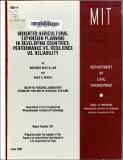Irrigated Agricultural Expansion Planning in Developing Countries: Performance vs. Resilience vs. Reliability
Author(s)
Allam, Mohamed Nasr; Marks, David H.
Download10793393.pdf (8.093Mb)
Metadata
Show full item recordAbstract
Agricultural expansion planning in developing countries where there is extensive government involvement in the planning process can be defined in a two level hierarchy. At the first level, strategic planning on the agricultural sector level is to be performed. At this level, the feasibility of the agricultural expansion as well as the other investments is to be examined and the role of each investment in achieving the strategic goals of the sector is to be determined. At the second level, analysis to the planning issues of agricultural expansion investment is to be provided. The analysis should be developed in such a way that the strategic decisions from the first level can be implemented. This report focuses only on the second planning level. Three issues are addressed. First, is the investment scheduling in such a way that the growing agricultural demands can be satisfied and the budget and resource constraints are not violated. The second issue is the income redistribution. The third issue is the uncertainty and its effect on the performance of agricultural expansion investment. A mathematical optimization model is built to aid in analyzing the scheduling problems of land development, crop selection, drainage water reuse, and capacity expansion of the irrigation and drainage networks. A minimum cost criterion is used, where costs of land development, farming, irrigation and drainage infrastructures, maintenance and operation, and pump stations are considered. The model is presented with a nonlinear objective function accounting for economies of scale and linear and nonlinear constraint sets. A fixed charge approximation is used for the non-convex cost functions and a mixed integer programming algorithm along with an enumeration procedure is used for solving the model. The solution procedure guarantees global optimality for the approximated problem. A hypothetical expansion on the order of 70,000 acres based on data from the Nile Delta in Egypt is used as a case study. The expansion extends over five areas of different sizes and soil types, and has only one source of fresh water for irrigation. The model is used for developing three alternate planning schemes for the case study. The first alternative is based on using fresh water for irrigation. The second alternative is based on using only saline water (drainage water of the existing cultivated areas) in irrigation. In the third alternative, the possibility of recycling the drainage water of the new land in irrigation after being mixed with fresh water is considered. The role of agricultural expansion investment in improving the income redistribution conditions in a society is investigated. The approach of distributing the new land to a poorer sector (landless farmers) is selected. A mathematical optimization model is built to determine the distribution of the land and a pricing policy established for the new areas in such a way that: 1) a specified income increase to the farmers can be achieved; 2) a predetermined level of recovery of the expansion cost can be insured; 3) high agricultural efficiency in the new lands can be maintained; and 4) redistribution benefits can be maximized. In a case study application of the model, no conflict is found between the economic efficiency and income redistribution criteria. For a specified cost recovery condition, it is found that the least cost planning alternatives give the opportunity to the largest number of landless farmers to own the new land and get a specified income increase from the agricultural revenues. But a conflict between the government return from the investment and income redistribution objectives is found. This conflict is addressed and the trade-off between the two objectives is illustrated. A multi-criteria optimization model is built to determine performance as well as operating rules of the agricultural systems under future uncertainties inherent in the planning parameters. Performance of agricultural systems is measured in terms of the economic efficiency and income redistribution criteria. The operating decisions are determined in such a way that the reduction in performance due to unpleasant surprises in the planning parameters can be minimized. The multi-criteria model is used in deriving the relationship between the performance of the case study under the different planning schemes and the unpleasant changes in the planning parameters. A resiliency index in terms of gradients of these functional relationships is provided. It is developed in deterministic as well as probabilistic framework. Based on this resiliency index, a definition of resilient system design is reached. A conflict between the resiliency and the cost of agricultural system designs is found. It is found that the overbuilt designs (the most costly designs) are the most resilient ones. The trade-off between the cost and the resiliency of the case study is derived and investigated.
Description
This study was sponsored by the M.I.T. Technology Adaptation Program which is funded through a grant from the Agency for International Development, United States Department of State.
Date issued
1983-06Publisher
Cambridge, Mass. : Ralph M. Parsons Laboratory, Hydrology and Water Resource Systems, Massachusetts Institute of Technology, Dept. of Civil Engineering
Other identifiers
291
Series/Report no.
R (Massachusetts Institute of Technology. Department of Civil Engineering) ; 83-18.Report (Ralph M. Parsons Laboratory for Water Resources and Hydrodynamics) ; 291.TAP report ; 83-18